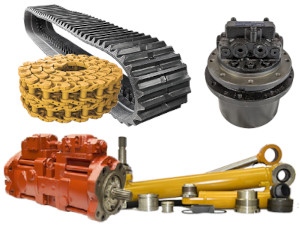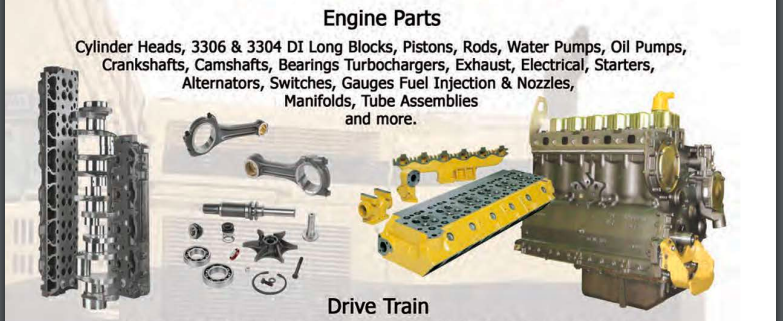Drive Efficiency and Integrity with Costs Aftermarket Construction Parts
Drive Efficiency and Integrity with Costs Aftermarket Construction Parts
Blog Article
Boost Effectiveness With Aftermarket Components: a Guide for Heavy Equipment Owners

Advantages of Aftermarket Parts
Owners of heavy equipment can appreciate countless benefits by opting for aftermarket parts over original tools producer (OEM) parts. Aftermarket parts are usually a lot more budget-friendly than OEM parts, allowing machinery owners to decrease maintenance and repair work costs without jeopardizing on quality.
Given that aftermarket suppliers specialize in creating specific components, equipment owners have accessibility to a broader range of options to match their requirements. Aftermarket parts are known for their high quality and integrity, with numerous meeting or surpassing OEM criteria.
Lastly, picking aftermarket components can also result in faster repair work and minimized downtime. With simpler schedule and quick delivery alternatives, equipment owners can obtain their devices up and running once again quickly, lessening disturbances to their procedures.
Choosing the Right Aftermarket Components
When taking into consideration aftermarket components for hefty machinery, it is important to focus on compatibility and high quality to make sure optimum performance and long life of the tools. Picking the appropriate aftermarket parts can be an important choice for hefty machinery owners as it straight impacts the effectiveness and reliability of their equipment.

Secondly, high quality should never be compromised when picking aftermarket components (aftermarket construction parts). Going with top notch elements makes sure resilience, dependability, and overall efficiency of the machinery. It is suggested to resource aftermarket components from reliable manufacturers or suppliers understood for their quality criteria
Additionally, taking into consideration elements such as warranties, customer reviews, and compatibility with existing systems can further help in making the right choice. By prioritizing compatibility and high quality when picking aftermarket parts, heavy equipment proprietors can improve the performance and long life of their tools.
Installment and Upkeep Tips
For reliable operation and durability of hefty machinery, appropriate installation and regular maintenance are paramount. When setting up aftermarket components, guarantee that you very carefully follow the producer's directions to ensure optimum performance. It is important to utilize the right tools and methods to prevent any damages throughout the setup process. Regular maintenance is critical to maintain your machinery running efficiently. Develop an upkeep schedule that consists of tasks such as examining fluid levels, evaluating for wear and tear, and cleaning components (aftermarket construction parts). Immediately resolve any kind of problems that arise to avoid more damage and pricey repairs. Furthermore, take into consideration purchasing training for your upkeep personnel to guarantee they have the needed abilities to determine and deal with possible issues. By focusing on installation and upkeep treatments, you can make Continued the most of the performance and lifespan of your heavy equipment, ultimately conserving money More Info and time in the long run.
Cost-Effectiveness of Aftermarket Components
Correct setup and regular upkeep are fundamental elements for heavy machinery owners intending to assess the cost-effectiveness of aftermarket components for their devices. While original equipment producer (OEM) parts are known for their high quality, aftermarket components supply a more cost-effective remedy without jeopardizing performance. The cost-effectiveness of aftermarket components ends up being obvious in numerous means. Aftermarket components are commonly more budget-friendly upfront, permitting owners to accomplish savings on first purchase costs. Additionally, these parts often give comparable performance to OEM parts, ensuring that the equipment runs efficiently without the requirement for expensive substitutes. Additionally, the accessibility of aftermarket parts from a large range of distributors advertises competition, leading to competitive prices and more cost financial savings for proprietors. By carefully reviewing the top quality and compatibility of aftermarket get rid of their equipment, proprietors can strike a balance between cost-effectiveness and performance, inevitably maximizing the performance and longevity of their hefty tools.
Maximizing Performance With Aftermarket Upgrades
To enhance operational performance and productivity, hefty machinery owners can efficiently take full advantage of effectiveness with calculated application of aftermarket upgrades. Aftermarket upgrades offer the possibility to customize hefty equipment to certain operational needs, resulting in improved performance and output. Upgrading elements such as engines, transmissions, hydraulic systems, and tracks can substantially enhance the total performance of the check my source equipment.

Frequently evaluating the performance of hefty equipment and identifying locations where aftermarket upgrades can be helpful is important for taking full advantage of efficiency. By purchasing high quality aftermarket parts and upgrades, machinery proprietors can accomplish greater levels of performance, eventually leading to cost financial savings and improved functional results.
Verdict
To conclude, aftermarket parts use various benefits for heavy machinery owners, including cost-effectiveness, increased efficiency, and modification options. By choosing the best aftermarket components, following correct setup and upkeep treatments, and making best use of upgrades, heavy machinery owners can improve their tools's efficiency and long life. Purchasing aftermarket parts can eventually bring about improved productivity and decreased downtime, making it a worthwhile consideration for proprietors looking to optimize their equipment operations.
Owners of hefty equipment can take pleasure in many benefits by opting for aftermarket parts over original devices maker (OEM) parts. Aftermarket parts are generally more cost effective than OEM parts, allowing machinery proprietors to minimize maintenance and repair work costs without endangering on high quality. By very carefully assessing the quality and compatibility of aftermarket components with their equipment, owners can strike an equilibrium between cost-effectiveness and performance, inevitably making best use of the effectiveness and longevity of their hefty devices.
In conclusion, aftermarket components provide countless advantages for hefty machinery proprietors, including cost-effectiveness, raised effectiveness, and customization alternatives. By choosing the appropriate aftermarket parts, adhering to appropriate installation and upkeep procedures, and optimizing upgrades, heavy equipment owners can improve their equipment's performance and longevity.
Report this page